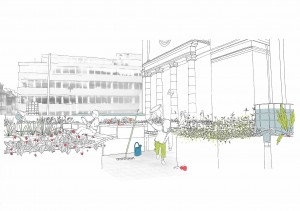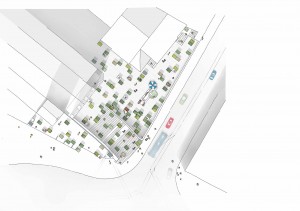Earthling + Seedling addresses the preciousness of resources such as water and energy, the cycle of growing, planting,
harvesting and enjoying plants for food and the relationships of people and place.
WATER AND ENERGY
Water is a resource which we tend to take for granted,
especially being so close to its source, and yet its scarcity is imminent. Rainwater harvesting for irrigation purposes is essential to successful urban agriculture projects. Water can be collected from rooftop surfaces by redirecting downspouts toward cisterns serving as temporary water retention and helping to decrease storm water influx.
Energy consciousness has taken a major turn in Switzerland but it remains largely the project of one generation while concerning the entire population. Earthling + Seedling seeks to bring the topic of energy to the heart of the city by raising awareness regarding production and storage of renewable energy.
The proposed concept aims to harness solar energy during the day and then to store that energy to be used at night by taking advantage of the level change between rainwater cisterns. During daytime the solar panels power a pump which raises water from the lower to the upper reservoir, and at nightfall the water stored in the upper cistern is released through a clear pipe fitted with micro-turbines that
produce the energy to light the cisterns.
PLANTS FOR FOOD
The proposed vegetal palette for Earthling + Seedling includes a wide variety of edible plants appropriate to the climate and growing season: vegetables, berries, aromatics and flowers. Particular care is given to ancient or unusual varieties and to companion plant associations.
The containers for planting are construction big bags resting on wooden pallets. The containers are set in three areas and managed by three different groups :
– by the LJ 2014 event, on the sidewalk and steps;
– by the church parish, in front of the church;
– by the neighborhood community, on the terrace.
During the preparation time leading up to the event, the interest of the church parish and of the neighborhood association are assessed so as to calibrate the adequate number of containers for each group.
The growing surfaces in the three areas are seeded, planted and maintained by the respective interest groups primarily using the water in the cisterns for irrigation and following an agreed upon set of site use standards and best practices.
Landing visitors will be free to enjoy the ambience created on the upper terrace and in front of the church and to help themselves to taste the small fruits, vegetables and aromatics planted on the stairs and lower sidewalk. Signage will help make explicit this less-than-natural urban habit regarding publicly produced and available produce.
PEOPLE AND PLACE
Appropriation of the place by a variety of people is one of the main objectives of this Landing. The appearance, from outer space, of productive plant containers on the site should provide interest not only to the visitors of the LJ event, but also to those from the
neighborhood who may begin a long-term engagement in the act of urban gardening, food production and caring for a shared and
currently underused space.
Throughout the duration of the event, Earthling + Seedling
provides the reason to inhabit and invest attention into a place which today remains a secret for many Lausannois.
The large picnic table offers a place of rest and exchange for visitors, passers-by and gardeners. The installation which has landed on
the space instigates unexpected interactions between fellow earthlings.
OBJECTIVES
Earthling + Seedling seeks to add a new dimension to urban culture by inserting a fresh landscape experience. It aims:
– to activate and energize an under-explored or used place,
– to add different dimensions to public space appropriation,
– to create a demonstration vegetable garden,
– to raise awareness about water recuperation and energy production.
DISSEMINATION
Landing is an ephemeral event, however after the closing, the proposed temporary planting sacks may be adopted on the site or transported elsewhere through a process of dissemination. The sacks and their pallets are transportable. They are suitable for mineral sites devoid of topsoil, or for situations where soil quality is questionable.
To aid in re-using the sacks, during the manifestation, a list of future adoptive gardeners or associations will be compiled and sites will be determined.
The seedlings of the event, pocket vegetable garden prototypes, may bear fruits elsewhere for earthlings in the future.
BENEFITS
Earthling + Seedling posits that multiple benefits may
emanate from the insertion of an urban garden of this type.
Urban integration
Small community managed vegetable gardens can positively
affect urban integration by creating new synergies, increasing
the diversity and heterogeneity of public spaces, contributing to the city’s landscape and environmental network, adding connections along existing paths network, and characterizing the identity of its neighborhood.
Spatial / architectural quality
The positive contribution of “green space” to urban life is
widely recognized and the demand for more “nature in the city” is increasing. “Fertile or cultivated nature” brings into the city some of the spatial qualities of productive landscapes and sets them into juxtaposition and dialog with the built
environment.
Small scale food production surfaces make better use of
under-used or residual spaces and provide attention and care to currently neglected or untended sites
Planted, well-organized and dynamically changing cultivated
urban patches can increase the aesthetic quality of a neighborhood as well as contribute to its spatial organization.
Carefully organized community gardens can attract new
gardeners and become models of replication.
Urban food productivity
Urban agriculture has the potential to provide an increased access to fresh and healthy unprocessed food. Gardening on such a scale can be remarkably productive when it is managed attentively (3 to 5 kg of produce / m2).
Environmental viability
Local food production can increase the opportunity for
biodiversity by offering a wide range of plant species and
providing habitat for animal species such as birds and insects.
Productive surfaces might increase a city’s capacity to better retain its stormwater.
Increased soil and vegetation decreases the urban heat island effect.
High levels of CO2 can be beneficial for plant production.
Social cohesion
Gardening can instigate celebration around key seasonal
moments, such as planting and harvesting, helping to construct temporal rituals, enhance one’s connection to nature and
seasonal cycles, and contribute to the experience of place and sense of belonging.
Collectively managed gardens allow those with less available time or energy to still participate in and benefit from the social advantages associated with the group activity.
Economic viability
In-kind income is generated from the produce of a family
garden. In communities with greatest economic insecurity, local food production can increase individual and local food security.
The urban population is growing more concerned with the provenance and quality of food and are expressing interest in investing more time into gardening activities and willingness to spend more for urban produce.
Management
There is an opportunity for urban authorities to develop partnerships with community organizations so as to share in the management of certain public or collective spaces. Neighborhood contracts are an existing example of partnerships, aimed at improving the quality of urban life.
Local food production searches to establish connections with neighborhood community groups, social centers, canteens, church congregations, large community kitchens, schools, homes, etc, which together can help enhance viability.
Conclusion
Through the creation of a temporary garden, Earthling +
Seedling come together to investigate how increased quality of life can be attained through the thoughtful integration of food production into the urban fabric.
Lausanne jardins 2014 proposition by VWA.






